integrated
learning
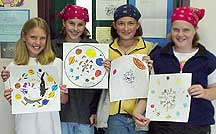 The mandala represents wholeness.
It is used as a holistic structure and format in educational workshops
to present factual information while demonstrating the interconnectedness
of all things. The mandala pattern offers a central hub from which all
educational subjects can be taught and is the perfect tool with which
to explore all aspects of life, from material to non-material. The mandala represents wholeness.
It is used as a holistic structure and format in educational workshops
to present factual information while demonstrating the interconnectedness
of all things. The mandala pattern offers a central hub from which all
educational subjects can be taught and is the perfect tool with which
to explore all aspects of life, from material to non-material.
The Mandala Project supports
an integrated approach to education and is a proponent of the Multiple
Intelligences Theory developed by Howard Gardner. (See Project
Zero). Building on proven studies showing that successful learning
involves the integration of both art and academic content, the project
has developed art workshops that can teach any subject, from geometry to history.
The value of Responsibility
is a key lesson of every workshop. It is the natural conclusion drawn from
discussions about the impact every person produces upon life, beginning
with the immediate surrounding and extending to the most remote.
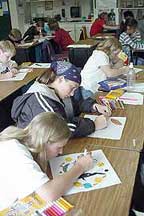 specific state learning
requirements specific state learning
requirements
are incorporated into a rich,
artistic, and fun format
The project is currently
focusing on the development of workshops for elementary grade levels which
incorporate state learning requirements.
Regardless of the workshop
topic, the theme of connectedness is carried throughout the workshop.
Every opportunity to draw attention to the interrelatedness of all things,
from mathematical concepts to human development, is utilized.
The Mandala Project offers
a variety of workshop topics from which to choose, as well as the option
to have a workshop custom-tailored to teach a specific lesson. The Project
encourages the participation of teachers in the workshops and welcomes
their input and specific content requests for incorporation into the lesson
plan.
putting
the project into action
In January, 2000, the first
Mandala Project workshops were piloted in Anacortes, WA, by Lori Bailey
Cunningham. After the completion of two successful workshops in the Anacortes
Middle School, the Anacortes School District Arts Cultural Education Coordinator
contracted for an additional five workshops to be taught at various elementary
schools in the district in the spring semester of 2000.
Since then, Bailey has facilitated
many mandala projects in schools and organizations nationally and internationally,
and has led workshops for teachers through Heritage Institute Online,
which offers fully accredited courses for educators. For more information
about Mandala Project Workshops, please contact our Project Director, Arlene West House.
building on the
center
Workshops in schools are
generally given in three-four day periods, and last from one to one and
a half hours each. Each workshop varies in content and structure depending
on the topic. The following is an overview of a typical workshop:
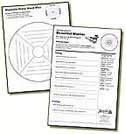 PART I PART I
A workshop begins with a general presentation
of the mandala which includes examples from science/nature, history
and art. The presentation utilizes several mediums, from slides to food
demonstrations, which give visual examples of the mandala pattern.
Students are invited to be active participants in all aspects of the
presentations. As sliced fruits revealing the mandala pattern are passed
around for observation (and consumption!), facilitators engage students
in dialogues that connect the mandala pattern seen at the micro (atomic
structure) level to the same structure observed at galactic levels.
This segment of the workshop is the core from which all other topical
studies develop.
-
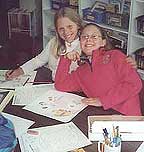 PART II PART II
As a warm-up exercise, students create
mini-mandalas. The facilitator uses these to create a collective
mandala. The concept of unique "whole" parts coming together
to create a larger whole is expressed in the creation of a collective
mandala quilt.
- PART III
The main theme of the project is presented.
Depending on the topic, a variety of mediums are used to teach the lesson.
Following the presentation is a discussion to generate ideas for symbols
to be used in the creation of personal mandalas. Worksheets are used
either in-class or as homework to help students gather content for the
creation of their mandalas.
- PART IV
Following presentation of basic art concepts
and techniques, students brainstorm ideas for creating mandalas. They
then create their own.
Students begin
by centering themselves and focusing on their stated goal: to create
a mandala that perfectly expresses the topic. Carefully selected music
or special videos related to the mandala may be played in the background
as the facilitator walks around the room helping students.
- PART V
Completed
mandalas are submitted to The Mandala Project for inclusion in the project
gallery. Students thereby experience the educational and creative
lessons contained in the workshop itself, as well as becoming part of
a larger experience involving the collective expressions of other people:
whole parts becoming part of a larger whole.
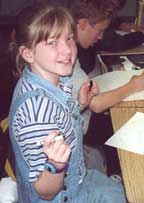 sharing our experience sharing our experience
One
of the project goals is to offer teachers and schools the ability to utilize
mandala concepts by incorporating Mandala Project lesson plans into their
own curriculum. To address this goal, The Mandala Project offers courses
for continuing education credit through The Heritage Institute. See Workshops for more information.
We
invite educators and parents to contact us with any questions or ideas
they wish to share. We encourage you to consider developing your own workshops
and are happy to consult with you regarding the development of a lesson
plan suited to your needs.
|
 specific state learning
requirements
specific state learning
requirements The mandala represents wholeness.
It is used as a holistic structure and format in educational workshops
to present factual information while demonstrating the interconnectedness
of all things. The mandala pattern offers a central hub from which all
educational subjects can be taught and is the perfect tool with which
to explore all aspects of life, from material to non-material.
The mandala represents wholeness.
It is used as a holistic structure and format in educational workshops
to present factual information while demonstrating the interconnectedness
of all things. The mandala pattern offers a central hub from which all
educational subjects can be taught and is the perfect tool with which
to explore all aspects of life, from material to non-material.  PART I
PART I PART II
PART II sharing our experience
sharing our experience